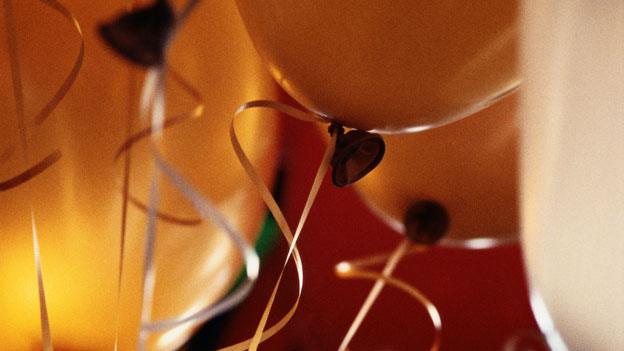Is it right to waste helium on party balloons?
- Published

The US has been selling off its helium reserve, established in the 1920s to provide gas for airships - but even so, shortages have been occurring.
Some scientists believe a finite resource that could one day run out should not be used for party balloons.
In the universe as a whole, it is one of the commonest elements, second only to hydrogen in its abundance. On Earth it is relatively rare, and one of the few elements that escapes gravity and leaks away into space.
"All of the other elements we've scattered around the globe, maybe we can go digging in garbage dumps to get them back," says chemist Andrea Sella, of University College London (UCL).
"But helium is unique. When it's gone it is lost to us forever."
Helium has the lowest boiling point of any element, at -269C, just a few degrees above absolute zero (-273C).
This makes it of key importance for superconducting magnets used in MRI scanners, which must be supercooled to generate the hugely powerful magnetic fields required.
"We're going to be looking back and thinking, I can't believe people just used to fill up their balloons with it, when it's so precious and unique," says Cambridge University chemist Peter Wothers, who has called for an end to helium-filled party balloons.
"It is something we need to think about."
That would mean an end to the old party favourite of breathing in helium from a balloon, and then talking in squeaky voices - a result of helium's fast-moving atoms. But maybe this would be no bad thing, as it can cause dizziness, headaches and even death.
The gas, which is formed by the decay of radioactive rocks in the earth's crust, accumulates in natural gas deposits and is collected as a by-product of the gas industry.
The United States is currently the world's biggest supplier, with the bulk of it stored near Amarillo, Texas, in the national helium reserve - which alone accounts for 35% of the world's current supply.
This was set up in 1925 as a strategic store for supplying gas to US airships, while after World War Two it provided coolant for missiles and rockets for the military and Nasa.

USS Shenandoah, the world's first helium-filled rigid airship
But since the mid-1990s, with growing civilian demand for helium in the manufacture of semiconductors and for MRI scanners, among other things, the US has been clawing back the cost of storing the gas by gradually selling it off on the open market.
Despite this, the price of helium has doubled over the past 10 years.
Scare stories about this or that resource running out are a commonplace of doomsayers - but this autumn, the world got a taste of what a helium shortage could mean.
US semiconductor manufacturers knew that under the terms of a 1996 law, the US helium reserve was legally obliged to turn off the tap last month.
Long in advance, alarm bells started ringing. Shortfalls in supply had anyway become routine.
"For most of the past year, we have only been receiving about 80% of the helium for which we have contracted," says Rodney Morgan of US chipmaker Micron Technology.
Such was the sense of urgency from the IT industry and others, that the legislation to avert this crisis was among a handful of bills passed in haste by the US Congress on the eve of the recent US government shutdown.
Yet while a "helium cliff" may have been averted, it is going to take time for other countries to be able to step into the market to supply the gas. The era of cheap helium is over for now.
Perhaps this is a good thing - after all, if a resource is finite then we should value it.
And as for those pesky helium balloons?
"I suspect the amount that is used in party balloons is quite small compared to the other main uses of it," says Dr Wothers.
"But it's just a rather trivial use of something we should be valuing a little bit more."
You can listen to Business Daily on BBC World Service at 08:32 GMT and 15:06 GMT.
Correction: An earlier version of this story mistakenly said that helium was the only element that escapes from Earth into space. It also referred to helium molecules, when it should have referred to helium atoms.